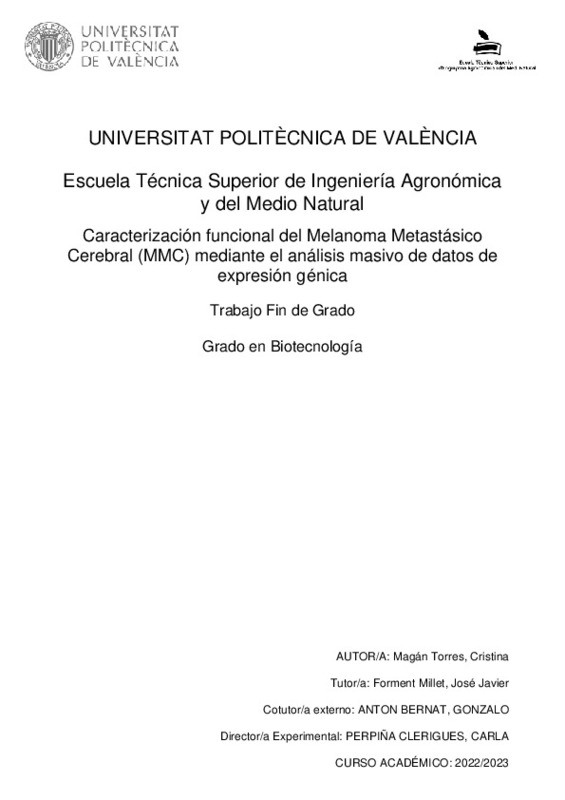|
Resumen:
|
[ES] El melanoma es la tercera fuente más común de metástasis cerebrales, superada sólo por el cáncer de pulmón y de mama, y es el tumor sólido con mayor propensión a dirigirse al cerebro. La incidencia de metástasis ...[+]
[ES] El melanoma es la tercera fuente más común de metástasis cerebrales, superada sólo por el cáncer de pulmón y de mama, y es el tumor sólido con mayor propensión a dirigirse al cerebro. La incidencia de metástasis cerebrales detectadas clínicamente en pacientes con melanoma avanzado es de aproximadamente el 40%, con un porcentaje mayor identificado en la autopsia. Estos pacientes, con melanoma metastásico cerebral (MMC), presentan la mayor morbilidad y mortalidad de los pacientes de melanoma.
Aunque en los últimos años se han realizado nuevos avances en la comprensión del melanoma metastásico cerebral que se pueden explotar con fines terapéuticos, sigue existiendo una gran necesidad médica no cubierta. Estos pacientes continúan teniendo pocas opciones clínicas, además, el conocimiento de los mecanismos moleculares y celulares responsables de la metástasis cerebral del melanoma sigue siendo limitado.
El objetivo de este trabajo es identificar biomarcadores de diagnóstico y pronóstico, que mejoren el tratamiento de los pacientes con MMC. Para ello, se llevó a cabo una revisión sistemática que permitió la selección de estudios centrados en MMC. A continuación, en cada uno de estos estudios se aplicó MetaFun, una herramienta web bioinformática para la caracterización molecular de enfermedades humanas. La estrategia bioinformática incluyó: un análisis exploratorio de los datos, un análisis de expresión diferencial entre los grupos de enfermos y controles, y un análisis de enriquecimiento funcional que permite detectar conjuntos de genes que se sobreexpresan o infraexpresan coordinadamente, compartiendo rutas y funciones biológicas.
Por último, el conjunto de estos resultados funcionales se ha metaanalizado obteniendo un perfil consenso sobre qué funciones están más o menos activadas en los pacientes con MMC. Analizando los resultados a nivel de términos GO, se detectó, a grandes rasgos, un enriquecimiento de las funciones relacionadas con la proliferación, replicación del ADN y división celular en los pacientes con melanoma. Frente a una relación de los procesos de queratinización, desarrollo epidermal y adhesión celular con los pacientes sanos.
Este mayor conocimiento de la enfermedad contribuye a un enfoque adaptado a la medicina personalizada de precisión, relacionando este trabajo con el Objetivo de Desarrollo Sostenible 3 (ODS 3) de Salud y Bienestar de la Agenda 2030 (Organización de las Naciones Unidas).
[-]
[EN] Melanoma is the third most common cause of brain metastases, surpassed only by lung and breast cancer, and is the solid tumor with the highest propensity to target the brain. The incidence of clinically detected brain ...[+]
[EN] Melanoma is the third most common cause of brain metastases, surpassed only by lung and breast cancer, and is the solid tumor with the highest propensity to target the brain. The incidence of clinically detected brain metastases in patients with advanced melanoma is approximately 40%, with an even higher percentage detected postmortem. These patients, with melanoma brain metastase (MBM), have the highest morbidity and mortality over all melanoma patients.
Although in recent years, new advances have been made in the understanding of brain metastatic melanoma that can be exploited for therapeutic purposes, there remains a large unmet medical need. These patients continue to have few clinical options; moreover, knowledge of the molecular and cellular mechanisms responsible for melanoma brain metastasis remains limited.
The aim of this work is to identify diagnostic and prognostic biomarkers that improve the treatment of patients with MBM. To this end, a systematic review was carried out to select studies focused on MBM. MetaFun, a bioinformatics web tool for the molecular characterization of human diseases, was then applied to each of these studies. The bioinformatics strategy included: an exploratory analysis of the data, a differential expression analysis between the disease and control groups, and a functional enrichment analysis to detect sets of genes that are coordinately over- or under-expressed, that share biological pathways and functions.
Finally, the set of these functional results has been meta-analyzed to obtain a consensus profile of which functions are more or less activated in patients with MBM. Analyzing the results at the level of GO terms, we detected, broadly speaking, an enrichment of functions related to proliferation, DNA replication and cell division in patients with melanoma. In contrast, the processes of keratinization, epidermal development and cell adhesion were related to healthy patients.
This further understanding of the disease would contribute to a tailored approach to personalized precision medicine, relating this work to Goal 3 on good health and well-being of the 2030 Agenda.
[-]
|








